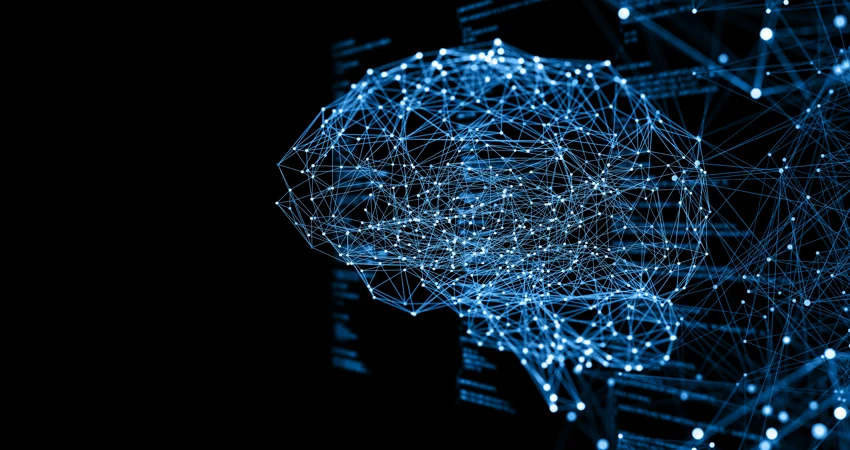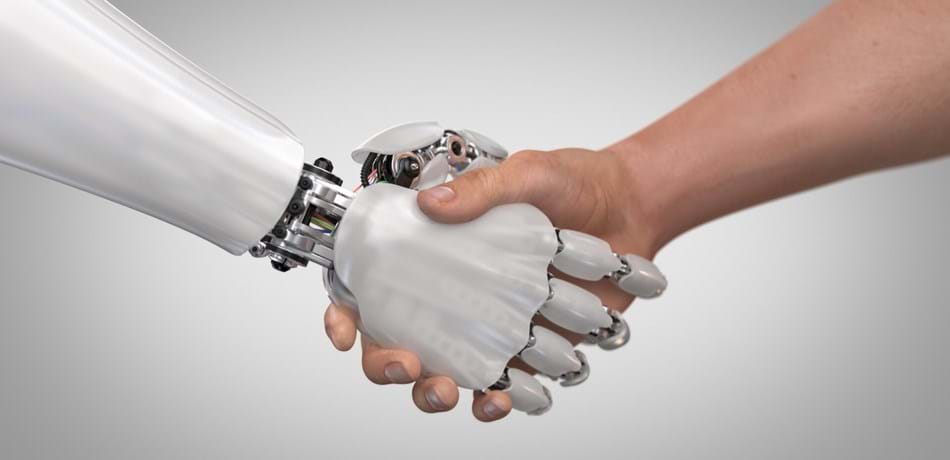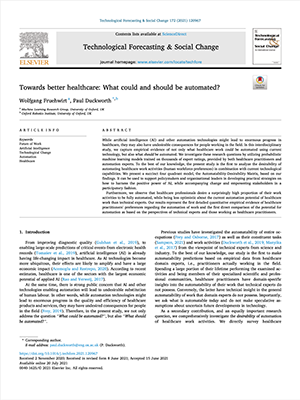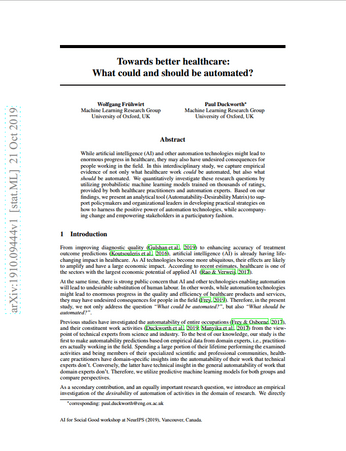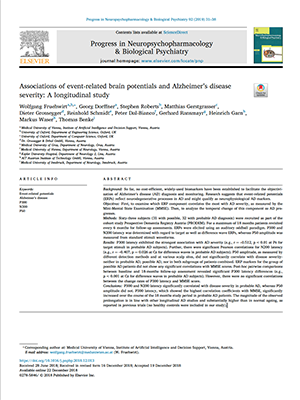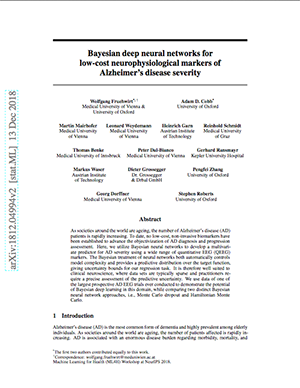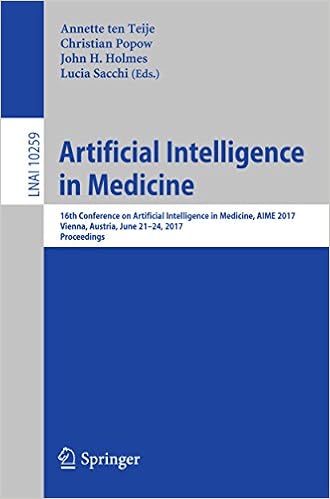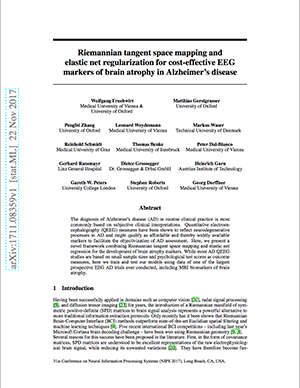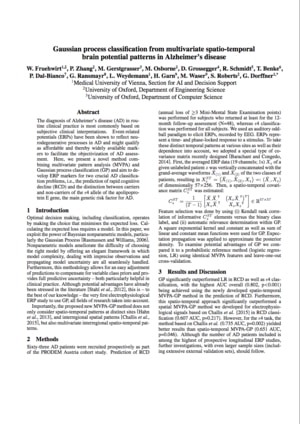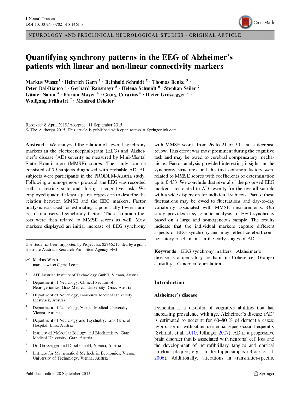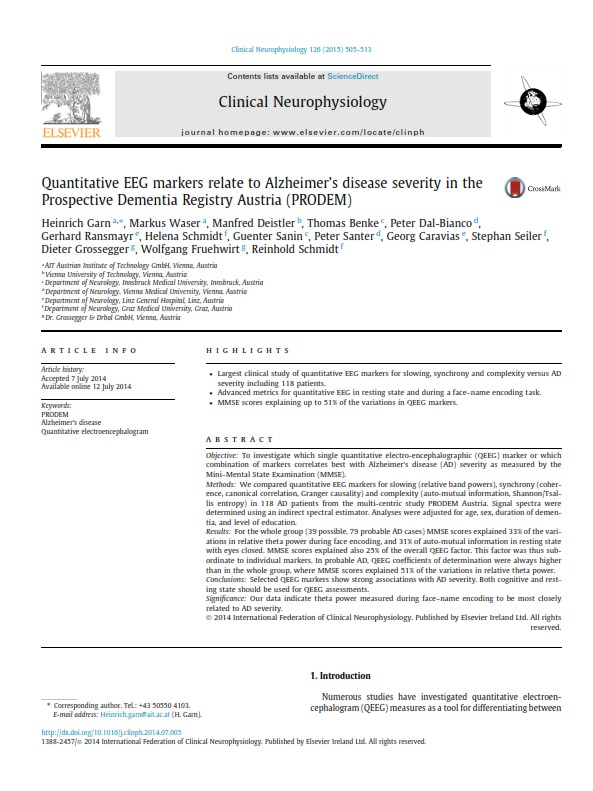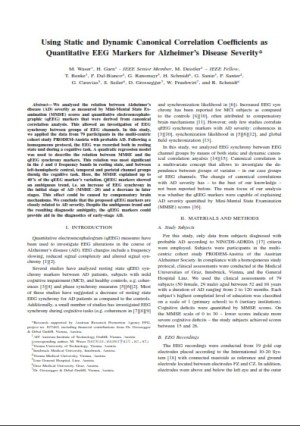In the News (2023)
AI & The Future of Work (Oxford Engineering)
Oxford Engineering highlights Wolfgang’s most recent contributions to AI and the Future of Work in a news article.
PROJECT PARTNERS
Wolfgang Fruehwirt (University of Oxford)
Paul Duckworth (University of Oxford)
Stephen Roberts (University of Oxford)
In the News (2022)
Future of Work: AI predicts what could and should be automated in healthcare (Oxford Engineering)
Oxford Engineering covers the latest project by Wolfgang Frühwirt and Paul Duckworth. They used Bayesian machine learning (AI) to better understand the Future of Work:
PROJECT PARTNERS
Wolfgang Fruehwirt (University of Oxford)
Paul Duckworth (University of Oxford)
Publications in the field of Future of Work (AI)
Technological Forecasting and Social Change (Elsevier 2021)
Towards better healthcare: What could and should be automated?
AUTHORS
Wolfgang Fruehwirt (University of Oxford)
Paul Duckworth (University of Oxford)
KEYWORDS
-Future of Work
-Artificial Intelligence
-Technological Change
-Automation
-Healthcare
ABSTRACT:
While artificial intelligence (AI) and other automation technologies might lead to enormous progress in healthcare, they may also have undesirable consequences for people working in the field. In this interdisciplinary study, we capture empirical evidence of not only what healthcare work could be automated using current technology, but also what should be automated. We investigate these research questions by utilizing probabilistic machine learning models trained on thousands of expert ratings, provided by both healthcare practitioners and automation experts. To the best of our knowledge, the present study is the first to analyze the desirability of automating healthcare work activities (human workforce preferences) in combination with current technological capabilities. We present a succinct four quadrant model, the Automatability-Desirability Matrix, based on our findings. It can be used to support policymakers and organizational leaders in developing practical strategies on how to harness the positive power of AI, while accompanying change and empowering stakeholders in a participatory fashion. Furthermore, we observe that healthcare professionals desire a surprisingly high proportion of their work activities to be fully automated, while being less optimistic about the current automation potential of healthcare work than technical experts. Our results represent the first detailed quantitative empirical evidence of healthcare practitioners’ preferences regarding the automation of work and the first direct comparison of the potential for automation as based on the perspectives of technical experts and those working as healthcare practitioners.
NeurIPS 2019 (Conference on Neural Information Processing Systems) (AI for Social Good Workshop)
Towards better healthcare: What could and should be automated?
AUTHORS
Wolfgang Fruehwirt (University of Oxford)
Paul Duckworth (University of Oxford)
ABSTRACT:
While artificial intelligence (AI) and other automation technologies might lead to enormous progress in healthcare, they may also have undesired consequences for people working in the field. In this interdisciplinary study, we capture empirical evidence of not only what healthcare work could be automated, but also what should be automated. We quantitatively investigate these research questions by utilizing probabilistic machine learning models trained on thousands of ratings, provided by both healthcare practitioners and automation experts. Based on our findings, we present an analytical tool (Automatability-Desirability Matrix) to support policymakers and organizational leaders in developing practical strategies on how to harness the positive power of automation technologies, while accompanying change and empowering stakeholders in a participatory fashion.
Publications in the field of Quantitative Finance (Data Science)
Finance Research Letters (Elsevier 2021)
Cumulation, Crash, Coherency: A Cryptocurrency Bubble Wavelet Analysis
AUTHORS
Wolfgang Fruehwirt (University of Oxford)
Leonhard Hochfilzer (University of Oxford)
Leonard Weydemann (Technical University of Vienna)
Stephen Roberts (University of Oxford)
HIGHLIGHTS
– First study of its kind to use intraday data (5-min resolution).
– Highly significant (p < 2.2e−16) structural change in the relationships between cryptocurrencies towards instability, as indicated by increased wavelet coherence after the Bitcoin peak.
– Robustness of findings demonstrated by extensive sensitivity analysis.
– Visualizations with high time-frequency resolution vividly depicting bubble dynamics.
– A large variety of well-known and lesser-known cryptocurrencies is considered.
ABSTRACT:
After its price peaked in 2017, Bitcoin lost almost half of its value in US Dollars within one month, which in turn is likely to have influenced the behavior of market participants many of who were lay investors. We hypothesize that after the peak, there was a structural change in the relationships between cryptocurrencies towards instability, as indicated by increased interdependence. We utilize wavelet coherence analysis of intraday data (5-minute resolution) to investigate the dynamics between a variety of cryptocurrencies in time-frequency space. Accompanied by visualizations depicting bubble dynamics, our robust and highly-significant quantitative results confirm our hypothesis.
Publications in the field of Neuroscience (AI & Data Science)
Progress in Neuropsychopharmacology & Biological Psychiatry (Elsevier 2019)
Associations of event-related brain potentials and Alzheimer’s disease severity: A longitudinal study
AUTHORS
Wolfgang Fruehwirt (Medical University of Vienna & University of Oxford)
Georg Dorffner (Medical University of Vienna)
Stephen Roberts (University of Oxford)
Matthias Gerstgrasser (University of Oxford)
Dieter Grossegger (Dr. Grossegger & Drbal GmbH)
Reinhold Schmidt (Medical University of Graz)
Peter Dal-Bianco (Medical University of Vienna)
Gerhard Ransmayr (Kepler University Hospital)
Heinrich Garn (Austrian Institute of Technology)
Markus Waser (Austrian Institute of Technology)
Thomas Benke (Medical University of Innsbruck)
KEYWORDS:
Event-related potentials, Alzheimer’s disease, P300, N200, P50
BACKGROUND:
So far, no cost-efficient, widely-used biomarkers have been established to facilitate the objectivization of Alzheimer’s disease (AD) diagnosis and monitoring. Research suggests that event-related potentials (ERPs) reflect neurodegenerative processes in AD and might qualify as neurophysiological AD markers.
OBJECTIVES:
First, to examine which ERP component correlates the most with AD severity, as measured by the Mini-Mental State Examination (MMSE). Then, to analyze the temporal change of this component as AD progresses.
METHODS:
Sixty-three subjects (31 with possible, 32 with probable AD diagnosis) were recruited as part of the cohort study Prospective Dementia Registry Austria (PRODEM). For a maximum of 18 months patients revisited every 6 months for follow-up assessments. ERPs were elicited using an auditory oddball paradigm. P300 and N200 latency was determined with regard to target as well as difference wave ERPs, whereas P50 amplitude was measured from standard stimuli waveforms.
RESULTS: P300 latency exhibited the strongest association with AD severity (e.g., r=–0.512, p<0.01 at Pz for target stimuli in probable AD subjects). Further, there were significant Pearson correlations for N200 latency (e.g., r=–0.407, p=0.026 at Cz for difference waves in probable AD subjects). P50 amplitude, as measured by different detection methods and at various scalp sites, did not significantly correlate with disease severity neither in probable AD, possible AD, nor in both subgroups of patients combined. ERP markers for the group of possible AD patients did not show any significant correlations with MMSE scores. Post-hoc pairwise comparisons between baseline and 18-months follow-up assessment revealed significant P300 latency differences (e.g., p<0.001 at Cz for difference waves in probable AD subjects). However, there were no significant correlations between the change rates of P300 latency and MMSE score.
CONCLUSIONS:
P300 and N200 latency significantly correlated with disease severity in probable AD, whereas P50 amplitude did not. P300 latency, which showed the highest correlation coefficients with MMSE, significantly increased over the course of the 18 months study period in probable AD patients. The magnitude of the observed prolongation is in line with other longitudinal AD studies and substantially higher than in normal ageing, as reported in previous trials (no healthy controls were included in our study).
NeurIPS 2018 (Conference on Neural Information Processing Systems)
Machine Learning for Health Workshop
Bayesian deep neural networks for low-cost neurophysiological markers of Alzheimer’s disease severity
AUTHORS
Wolfgang Fruehwirt (Medical University of Vienna & University of Oxford)
Adam Cobb (University of Oxford)
Martin Mairhofer (Medical University of Vienna)
Leonard Weydemann (Medical University of Vienna)
Heinrich Garn (Austrian Institute of Technology)
Reinhold Schmidt (Medical University of Graz)
Thomas Benke (Medical University of Innsbruck)
Peter Dal-Bianco (Medical University of Vienna)
Gerhard Ransmayr (Linz General Hospital)
Markus Waser (Austrian Institute of Technology)
Dieter Grossegger (Dr. Grossegger & Drbal GmbH)
Pengfei Zhang (University of Oxford)
Georg Dorffner (Medical University of Vienna)
Stephen Roberts (University of Oxford)
KEYWORDS:
Deep learning, Alzheimer’s disease, Artificial intelligence, Neural networks, Neuroscience
ABSTRACT
As societies around the world are ageing, the number of Alzheimer’s disease (AD) patients is rapidly increasing. To date, no low-cost, non-invasive biomarkers have been established to advance the objectivization of AD diagnosis and progression assessment. Here, we utilize Bayesian neural networks to develop a multivariate predictor for AD severity using a wide range of quantitative EEG (QEEG) markers. The Bayesian treatment of neural networks both automatically controls model complexity and provides a predictive distribution over the target function, giving uncertainty bounds for our regression task. It is therefore well suited to clinical neuroscience, where data sets are typically sparse and practitioners require a precise assessment of the predictive uncertainty. We use data of one of the largest prospective AD EEG trials ever conducted to demonstrate the potential of Bayesian deep learning in this domain, while comparing two distinct Bayesian neural network approaches, i.e., Monte Carlo dropout and Hamiltonian Monte Carlo.
AIME 2017 (Artificial Intelligence in Medicine) (Springer 2017)
Bayesian Gaussian Process Classification from Event-Related Brain Potentials in Alzheimer’s Disease
AUTHORS
Wolfgang Fruehwirt (1, 2) – Pengfei Zhang (2) – Matthias Gerstgrasser (3) – Dieter Grossegger (4) – Reinhold Schmidt (5) – Thomas Benke (6) – Peter Dal-Bianco (7) – Gerhard Ransmayr (8) – Leonard Weydemann (1) – Heinrich Garn (9) – Markus Waser (9) – Michael Osborne (2) – Georg Dorffner (1)
AFFILIATION
(1) Medical University of Vienna, Section for AI and Decision Support
(2) University of Oxford, Department of Engineering Science, Machine Learning Research Group
(3) University of Oxford, Department of Computer Science
(4) Dr. Grossegger & Drbal GmbH
(5) Medical University of Graz, Department of Neurology
(6) Medical University of Innsbruck, Department of Neurology
(7) Medical University of Vienna, Department of Neurology
(8) Linz General Hospital, Department of Neurology
(9) AIT Austrian Institute of Technology GmbH
KEYWORDS
Machine learning, Gaussian process classification, Event-related potentials, Alzheimer’s disease, Single subject classification
ABSTRACT
Event-related potentials (ERPs) have been shown to reflect neurodegenerative processes in Alzheimer’s disease (AD) and might qualify as non-invasive and cost-effective markers to facilitate the objectivization of AD assessment in daily clinical practice. Lately, the combination of multivariate pattern analysis (MVPA) and Gaussian process classification (GPC) has gained interest in the neuroscientific community. Here, we demonstrate how a MVPA-GPC approach can be applied to electrophysiological data. Furthermore, in order to account for the temporal information of ERPs, we develop a novel method that integrates interregional synchrony of ERP time signatures. By using real-life ERP recordings of a prospective AD cohort study, we empirically investigate the usefulness of the proposed framework to build neurophysiological markers for single subject classification tasks.
NIPS 2017 (Conference on Neural Information Processing Systems)
Machine Learning for Health Workshop
Riemannian tangent space mapping and elastic net regularization for cost-effective EEG markers of brain atrophy in Alzheimer’s disease
AUTHORS
W. Fruehwirt (1,2), M. Gerstgrasser (2), P. Zhang (2), L. Weydemann (1), M. Waser (3), R. Schmidt (4), T. Benke (5), P. Dal-Bianco (1), G. Ransmayr (6), D. Grossegger (7), H. Garn (8), G. W. Peters (9), S. Roberts (2), G. Dorffner (1)
AFFILIATION
(1) Medical University of Vienna
(2) University of Oxford
(3) Technical University of Denmark
(4) Medical University of Graz
(5) Medical University of Innsbruck
(6) Linz General Hospital
(7) Dr. Grossegger & Drbal GmbH
(8) AIT Austrian Institute of Technology GmbH
(9) University College London
KEYWORDS
Machine learning, Riemannian geometry, Elastic net regression, EEG, MRI, Alzheimer’s disease
ABSTRACT
The diagnosis of Alzheimer’s disease (AD) in routine clinical practice is most commonly based on subjective clinical interpretations. Quantitative electroencephalography (QEEG) measures have been shown to reflect neurodegenerative processes in AD and might qualify as affordable and thereby widely available markers to facilitate the objectivization of AD assessment. Here, we present a novel framework combining Riemannian tangent space mapping and elastic net regression for the development of brain atrophy markers. While most AD QEEG studies are based on small sample sizes and psychological test scores as outcome measures, here we train and test our models using data of one of the largest prospective EEG AD trials ever conducted, including MRI biomarkers of brain atrophy.
IJCAI 2017 (International Joint Conference on Artificial Intelligence)
BOOM – Workshop on biomedical informatics with optimization and machine learning
Gaussian process classification from multivariate spatio-temporal brain potential patterns in Alzheimer’s disease
AUTHORS
Wolfgang Fruehwirt (1, 2) – Pengfei Zhang (2) – Matthias Gerstgrasser (3) – Michael Osborne (2) – Dieter Grossegger (4) – Reinhold Schmidt (5) – Thomas Benke (6) – Peter Dal-Bianco (7) – Gerhard Ransmayr (8) – Leonard Weydemann (1) – Heinrich Garn (9) – Markus Waser (9) – Stephen Roberts (2) – Georg Dorffner (1)
AFFILIATION
(1) Medical University of Vienna, Section for AI and Decision Support
(2) University of Oxford, Department of Engineering Science, Machine Learning Research Group
(3) University of Oxford, Department of Computer Science
(4) Dr. Grossegger & Drbal GmbH
(5) Medical University of Graz, Department of Neurology
(6) Medical University of Innsbruck, Department of Neurology
(7) Medical University of Vienna, Department of Neurology
(8) Linz General Hospital, Department of Neurology
(9) AIT Austrian Institute of Technology GmbH
KEYWORDS
Machine learning, Gaussian process classification, Event-related potentials, Alzheimer’s disease, Single subject classification
ABSTRACT
The diagnosis of Alzheimer’s disease (AD) in routine clinical practice is most commonly based on subjective clinical interpretations. Event-related potentials (ERPs) have been shown to reflect neurodegenerative processes in AD and might qualify as affordable and thereby widely available markers to facilitate the objectivization of AD assessment. Here, we present a novel method com- bining multivariate pattern analysis (MVPA) and Gaussian process classification (GP) and aim to develop ERP markers for two crucial AD classifica- tion problems, i.e., the prediction of rapid cognitive decline (RCD) and the distinction between carriers and non-carriers of the ε4 allele of the apolipopro- tein E gene, the main genetic risk factor for AD.
Journal of Neural Transmission (Springer 2016)
Quantifying synchrony patterns in the EEG of Alzheimer’s patients with linear and non-linear connectivity markers
AUTHORS
Markus Waser · Heinrich Garn · Reinhold Schmidt · Thomas Benke · Peter Dal-Bianco · Gerhard Ransmayr · Helena Schmidt · Stephan Seiler · Günter Sanin · Florian Mayer · Georg Caravias · Dieter Grossegger · Wolfgang Frühwirt · Manfred Deistler
RESEARCH PARTNERS
AIT (Austrian Institute of Technology), Department of Neurology (Graz Medical University), Department of Neurology (Innsbruck Medical University), Department of Neurology (Vienna Medical University), Department of Neurology and Psychiatry (Linz General Hospital), Institute of Molecular Biology and Biochemistry (Graz Medical University), Dr. Grossegger and Drbal GmbH, Institute for Mathematical Methods in Economics (Vienna University of Technology)
ABSTRACT
We analyzed the relation of several synchrony markers in the electroencephalogram (EEG) and Alzheimer’s disease (AD) severity as measured by Mini-Mental State Examination (MMSE) scores. The study sample consisted of 79 subjects diagnosed with probable AD. All subjects were participants in the PRODEM-Austria study. Following a homogeneous protocol, the EEG was recorded both in resting state and during a cognitive task. We employed quadratic least squares regression to describe the relation between MMSE and the EEG markers. Factor analysis was used for estimating a potentially lower number of unobserved synchrony factors. These common factors were then related to MMSE scores as well. Most markers displayed an initial increase of EEG synchrony with MMSE scores from 26 to 21 or 20, and a decrease below. This effect was most prominent during the cognitive task and may be owed to cerebral compensatory mechanisms. Factor analysis provided interesting insights in the synchrony structures and the first common factors were related to MMSE scores with coefficients of determination up to 0.433. We conclude that several of the proposed EEG markers are related to AD severity for the overall sample with a wide dispersion for individual subjects. Part of these fluctuations may be owed to fluctuations and day-to-day variability associated with MMSE measurements. Our study provides a systematic analysis of EEG synchrony based on a large and homogeneous sample. The results indicate that the individual markers capture different aspects of EEG synchrony and may reflect cerebral compensatory mechanisms in the early stages of AD.
KEYWORDS
Alzheimer’s disease; Canonical correlation; Coherence; Compensatory mechanism; EEG synchrony markers; Granger causality
Clinical Neurophysiology (Elsevier 2015)
Quantitative EEG markers relate to Alzheimer’s disease severity in the Prospective Dementia Registry Austria (PRODEM)
AUTHORS
Heinrich Garn, Markus Waser, Manfred Deistler, Thomas Benke, Peter Dal-Bianco, Gerhard Ransmayr, Helena Schmidt, Guenter Sanin, Peter Santer, Georg Caravias, Stephan Seiler, Dieter Grossegger, Wolfgang Fruehwirt, Reinhold Schmidt
RESEARCH PARTNERS
AIT (Austrian Institute of Technology), Vienna University of Technology, Department of Neurology (Innsbruck Medical University), Department of Neurology (Vienna Medical University), Department of Neurology (Linz General Hospital), Department of Neurology (Graz Medical University), Dr. Grossegger & Drbal GmbH
HIGHLIGHTS
– Largest clinical study of quantitative EEG markers for slowing, synchrony and complexity severity including 118 patients.
– Advanced metrics for quantitative EEG in resting state and during a face–name encoding
– MMSE scores explaining up to 51% of the variations in QEEG markers.
OBJECTIVE
To investigate which single quantitative electro-encephalographic (QEEG) marker or which combination of markers correlates best with Alzheimer’s disease (AD) severity as measured by the Mini-Mental State Examination (MMSE).
METHODS
We compared quantitative EEG markers for slowing (relative band powers), synchrony (coherence, canonical correlation, Granger causality) and complexity (auto-mutual information, Shannon/Tsallis entropy) in 118 AD patients from the multi-centric study PRODEM Austria. Signal spectra were determined using an indirect spectral estimator. Analyses were adjusted for age, sex, duration of dementia, and level of education.
RESULTS
For the whole group (39 possible, 79 probable AD cases) MMSE scores explained 33% of the variations in relative theta power during face encoding, and 31% of auto-mutual information in resting state with eyes closed. MMSE scores explained also 25% of the overall QEEG factor. This factor was thus subordinate to individual markers. In probable AD, QEEG coefficients of determination were always higher than in the whole group, where MMSE scores explained 51% of the variations in relative theta power.
CONCLUSIONS
Selected QEEG markers show strong associations with AD severity. Both cognitive and resting state should be used for QEEG assessments.
SIGNIFICANCE
Our data indicate theta power measured during face-name encoding to be most closely related to AD severity.
Engineering in Medicine and Biology Society (IEEE 2014)
Using static and dynamic canonical correlation coefficients as quantitative EEG markers for Alzheimer’s disease severity
AUTHORS
Heinrich Garn, Markus Waser, Manfred Deistler, Thomas Benke, Peter Dal-Bianco, Gerhard Ransmayr, Helena Schmidt, Guenter Sanin, Peter Santer, Georg Caravias, Stephan Seiler, Dieter Grossegger, Wolfgang Fruehwirt, Reinhold Schmidt
RESEARCH PARTNERS
AIT (Austrian Institute of Technology), Vienna University of Technology, Department of Neurology (Innsbruck Medical University), Department of Neurology (Vienna Medical University), Department of Neurology (Linz General Hospital), Department of Neurology (Graz Medical University), Dr. Grossegger & Drbal GmbH
ABSTRACT
We analyzed the relation between Alzheimer’s disease (AD) severity as measured by Mini-Mental State Examination (MMSE) scores and quantitative electroencephalographic (qEEG) markers that were derived from canonical correlation analysis. This allowed an investigation of EEG synchrony between groups of EEG channels. In this study, we applied the data from 79 participants in the multi-centric cohort study PRODEM-Austria with probable AD. Following a homogeneous protocol, the EEG was recorded both in resting state and during a cognitive task. A quadratic regression model was used to describe the relation between MMSE and the qEEG synchrony markers. This relation was most significant in the δ and θ frequency bands in resting state, and between left-hemispheric central, temporal and parietal channel groups during the cognitive task. Here, the MMSE explained up to 40% of the qEEG marker’s variation. QEEG markers showed an ambiguous trend, i.e. an increase of EEG synchrony in the initial stage of AD (MMSE>20) and a decrease in later stages. This effect could be caused by compensatory brain mechanisms. We conclude that the proposed qEEG markers are closely related to AD severity. Despite the ambiguous trend and the resulting diagnostic ambiguity, the qEEG markers could provide aid in the diagnostics of early-stage AD.
Coaching-Termin vereinbaren
Bei einem ersten Coaching-Termin können wir Ihre Fragestellung näher abklären und konkrete Schritte einleiten:
